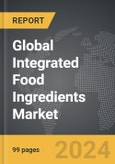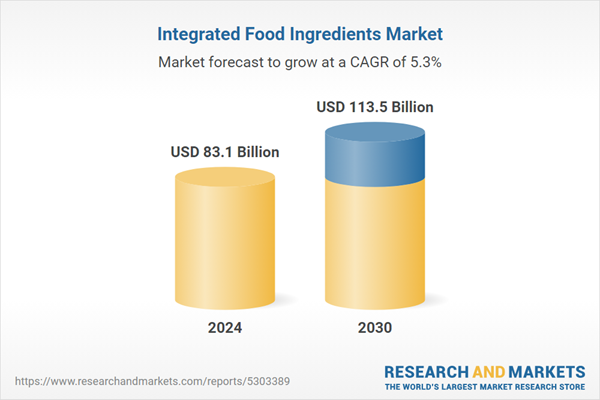The global market for Integrated Food Ingredients was valued at US$83.1 Billion in 2024 and is projected to reach US$113.5 Billion by 2030, growing at a CAGR of 5.3% from 2024 to 2030. This comprehensive report provides an in-depth analysis of market trends, drivers, and forecasts, helping you make informed business decisions. The report includes the most recent global tariff developments and how they impact the Integrated Food Ingredients market.
Segments: Function (Taste Enhancers, Coloring, Form, Texture, Preservation); Integrated Solution (Meat Products, Beverage, Bakery & Confectionery, Snacks & Savory, Dairy).
Geographic Regions/Countries: World; United States; Canada; Japan; China; Europe (France; Germany; Italy; United Kingdom; Spain; Russia; and Rest of Europe); Asia-Pacific (Australia; India; South Korea; and Rest of Asia-Pacific); Latin America (Argentina; Brazil; Mexico; and Rest of Latin America); Middle East (Iran; Israel; Saudi Arabia; United Arab Emirates; and Rest of Middle East); and Africa.
The analysts continuously track trade developments worldwide, drawing insights from leading global economists and over 200 industry and policy institutions, including think tanks, trade organizations, and national economic advisory bodies. This intelligence is integrated into forecasting models to provide timely, data-driven analysis of emerging risks and opportunities.
Global Integrated Food Ingredients Market - Key Trends and Drivers Summarized
Why Are Integrated Food Ingredients Crucial for the Food and Beverage Industry?
Integrated food ingredients are essential components in the food and beverage industry, serving multiple functions such as flavor enhancement, texture improvement, shelf-life extension, and nutritional fortification. These ingredients include a combination of emulsifiers, stabilizers, thickeners, preservatives, and flavor enhancers that work together to create consistent, high-quality food products. By integrating various functional ingredients into one solution, food manufacturers can streamline their production processes and meet consumer demands for healthier, cleaner, and more natural products. Integrated food ingredients are widely used in processed foods, bakery products, dairy, and beverages, where consistency and product stability are key to maintaining brand reputation and customer satisfaction.How Are Technological Advancements Shaping the Integrated Food Ingredients Market?
Technological advancements are significantly enhancing the functionality and versatility of integrated food ingredients. New extraction and processing techniques, such as enzymatic extraction and fermentation, are allowing manufacturers to derive natural ingredients from plants and microorganisms, reducing reliance on synthetic additives. Additionally, advancements in encapsulation technologies are improving the delivery and stability of active ingredients, such as vitamins and probiotics, ensuring they retain their effectiveness throughout the product’s shelf life. The use of clean-label technologies, which involve using natural and recognizable ingredients, is also gaining momentum as consumers seek healthier, additive-free food options. These innovations are driving the development of integrated food ingredients that meet the growing demand for natural, functional, and sustainable food products.How Do Market Segments Define the Growth of the Integrated Food Ingredients Market?
Key functions of these ingredients include flavoring, texturizing, preserving, and nutrient enhancement, with texturizing agents leading the market due to their widespread use in dairy, bakery, and processed foods. Ingredient types include emulsifiers, stabilizers, preservatives, and enzymes, with emulsifiers holding a significant share as they are vital in maintaining product consistency in a wide range of food applications. Applications of integrated food ingredients span across dairy, beverages, bakery, processed foods, and nutritional supplements, with processed foods representing the largest segment due to the high demand for convenience foods. The market is expanding rapidly in regions like Asia-Pacific, where growing urbanization and changing lifestyles are driving demand for processed and convenience foods.What Factors Are Driving the Growth in the Integrated Food Ingredients Market?
The growth in the integrated food ingredients market is driven by several factors, including increasing consumer demand for convenience foods, advancements in food technology, and the rising trend toward clean-label and natural products. As urbanization accelerates, consumers are seeking convenient, ready-to-eat food options that maintain quality and nutritional value, driving the demand for integrated food ingredients that offer functional benefits like shelf-life extension and texture improvement. Technological innovations in natural ingredient extraction and encapsulation are also contributing to market growth by enabling the development of healthier, more sustainable food products. Additionally, the clean-label movement, which emphasizes transparency in food production and ingredients, is pushing manufacturers to adopt integrated ingredients that align with consumer preferences for natural and minimally processed foods.Report Scope
The report analyzes the Integrated Food Ingredients market, presented in terms of units. The analysis covers the key segments and geographic regions outlined below.Segments: Function (Taste Enhancers, Coloring, Form, Texture, Preservation); Integrated Solution (Meat Products, Beverage, Bakery & Confectionery, Snacks & Savory, Dairy).
Geographic Regions/Countries: World; United States; Canada; Japan; China; Europe (France; Germany; Italy; United Kingdom; Spain; Russia; and Rest of Europe); Asia-Pacific (Australia; India; South Korea; and Rest of Asia-Pacific); Latin America (Argentina; Brazil; Mexico; and Rest of Latin America); Middle East (Iran; Israel; Saudi Arabia; United Arab Emirates; and Rest of Middle East); and Africa.
Key Insights:
- Market Growth: Understand the significant growth trajectory of the Taste Enhancers segment, which is expected to reach US$38.8 Billion by 2030 with a CAGR of a 5.9%. The Coloring segment is also set to grow at 5.0% CAGR over the analysis period.
- Regional Analysis: Gain insights into the U.S. market, valued at $21.6 Billion in 2024, and China, forecasted to grow at an impressive 8.5% CAGR to reach $26.2 Billion by 2030. Discover growth trends in other key regions, including Japan, Canada, Germany, and the Asia-Pacific.
Why You Should Buy This Report:
- Detailed Market Analysis: Access a thorough analysis of the Global Integrated Food Ingredients Market, covering all major geographic regions and market segments.
- Competitive Insights: Get an overview of the competitive landscape, including the market presence of major players across different geographies.
- Future Trends and Drivers: Understand the key trends and drivers shaping the future of the Global Integrated Food Ingredients Market.
- Actionable Insights: Benefit from actionable insights that can help you identify new revenue opportunities and make strategic business decisions.
Key Questions Answered:
- How is the Global Integrated Food Ingredients Market expected to evolve by 2030?
- What are the main drivers and restraints affecting the market?
- Which market segments will grow the most over the forecast period?
- How will market shares for different regions and segments change by 2030?
- Who are the leading players in the market, and what are their prospects?
Report Features:
- Comprehensive Market Data: Independent analysis of annual sales and market forecasts in US$ Million from 2024 to 2030.
- In-Depth Regional Analysis: Detailed insights into key markets, including the U.S., China, Japan, Canada, Europe, Asia-Pacific, Latin America, Middle East, and Africa.
- Company Profiles: Coverage of players such as Ajinomoto Co., Inc., Amway Corporation, Archer-Daniels-Midland Company, Arla Foods amba, Associated British Foods plc and more.
- Complimentary Updates: Receive free report updates for one year to keep you informed of the latest market developments.
Some of the 53 companies featured in this Integrated Food Ingredients market report include:
- Ajinomoto Co., Inc.
- Amway Corporation
- Archer-Daniels-Midland Company
- Arla Foods amba
- Associated British Foods plc
- BASF
- Cargill Incorporated
- DMH Ingredients Inc.
- Dohler
- DSM
- Firmenich Sa
- Gat Foods
- General Mills Inc.
- Ingredion Incorporated
- International Flavors & Fragrances
- Kerry Group plc
- Koninklijke DSM N.V.
- Northwest Naturals
- Symrise
- Tate & Lyle
Tariff Impact Analysis: Key Insights for 2025
Global tariff negotiations across 180+ countries are reshaping supply chains, costs, and competitiveness. This report reflects the latest developments as of April 2025 and incorporates forward-looking insights into the market outlook.The analysts continuously track trade developments worldwide, drawing insights from leading global economists and over 200 industry and policy institutions, including think tanks, trade organizations, and national economic advisory bodies. This intelligence is integrated into forecasting models to provide timely, data-driven analysis of emerging risks and opportunities.
What’s Included in This Edition:
- Tariff-adjusted market forecasts by region and segment
- Analysis of cost and supply chain implications by sourcing and trade exposure
- Strategic insights into geographic shifts
Buyers receive a free July 2025 update with:
- Finalized tariff impacts and new trade agreement effects
- Updated projections reflecting global sourcing and cost shifts
- Expanded country-specific coverage across the industry
Table of Contents
I. METHODOLOGYII. EXECUTIVE SUMMARY2. FOCUS ON SELECT PLAYERSIII. MARKET ANALYSISCANADAITALYSPAINRUSSIAREST OF EUROPESOUTH KOREAREST OF ASIA-PACIFICARGENTINABRAZILMEXICOREST OF LATIN AMERICAIRANISRAELSAUDI ARABIAUNITED ARAB EMIRATESREST OF MIDDLE EASTIV. COMPETITION
1. MARKET OVERVIEW
3. MARKET TRENDS & DRIVERS
4. GLOBAL MARKET PERSPECTIVE
UNITED STATES
JAPAN
CHINA
EUROPE
FRANCE
GERMANY
UNITED KINGDOM
ASIA-PACIFIC
AUSTRALIA
INDIA
LATIN AMERICA
MIDDLE EAST
AFRICA
Companies Mentioned (Partial List)
A selection of companies mentioned in this report includes, but is not limited to:
- Ajinomoto Co., Inc.
- Amway Corporation
- Archer-Daniels-Midland Company
- Arla Foods amba
- Associated British Foods plc
- BASF
- Cargill Incorporated
- DMH Ingredients Inc.
- Dohler
- DSM
- Firmenich Sa
- Gat Foods
- General Mills Inc.
- Ingredion Incorporated
- International Flavors & Fragrances
- Kerry Group plc
- Koninklijke DSM N.V.
- Northwest Naturals
- Symrise
- Tate & Lyle
Table Information
| Report Attribute | Details |
|---|---|
| No. of Pages | 99 |
| Published | April 2025 |
| Forecast Period | 2024 - 2030 |
| Estimated Market Value ( USD | $ 83.1 Billion |
| Forecasted Market Value ( USD | $ 113.5 Billion |
| Compound Annual Growth Rate | 5.3% |
| Regions Covered | Global |









